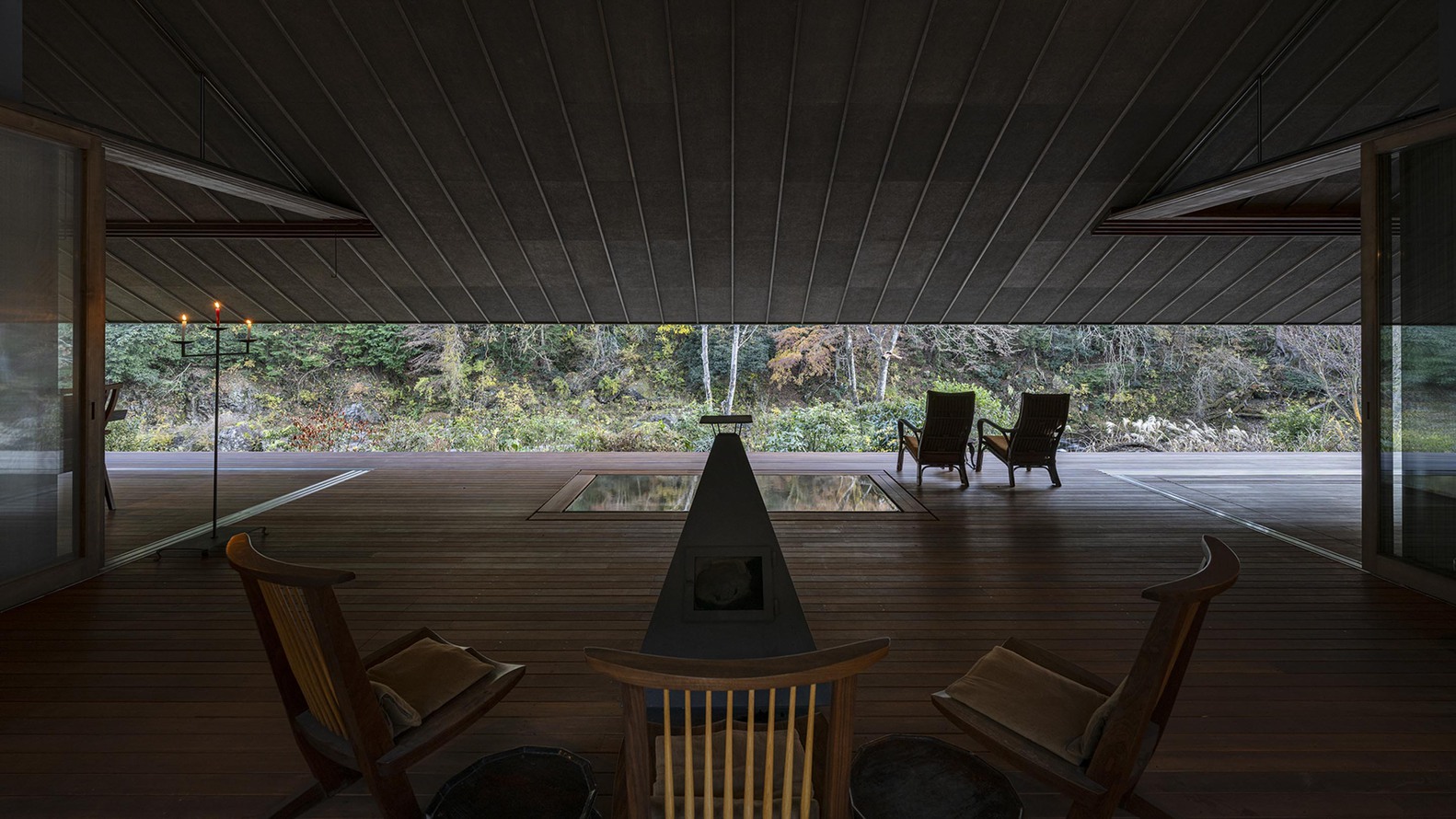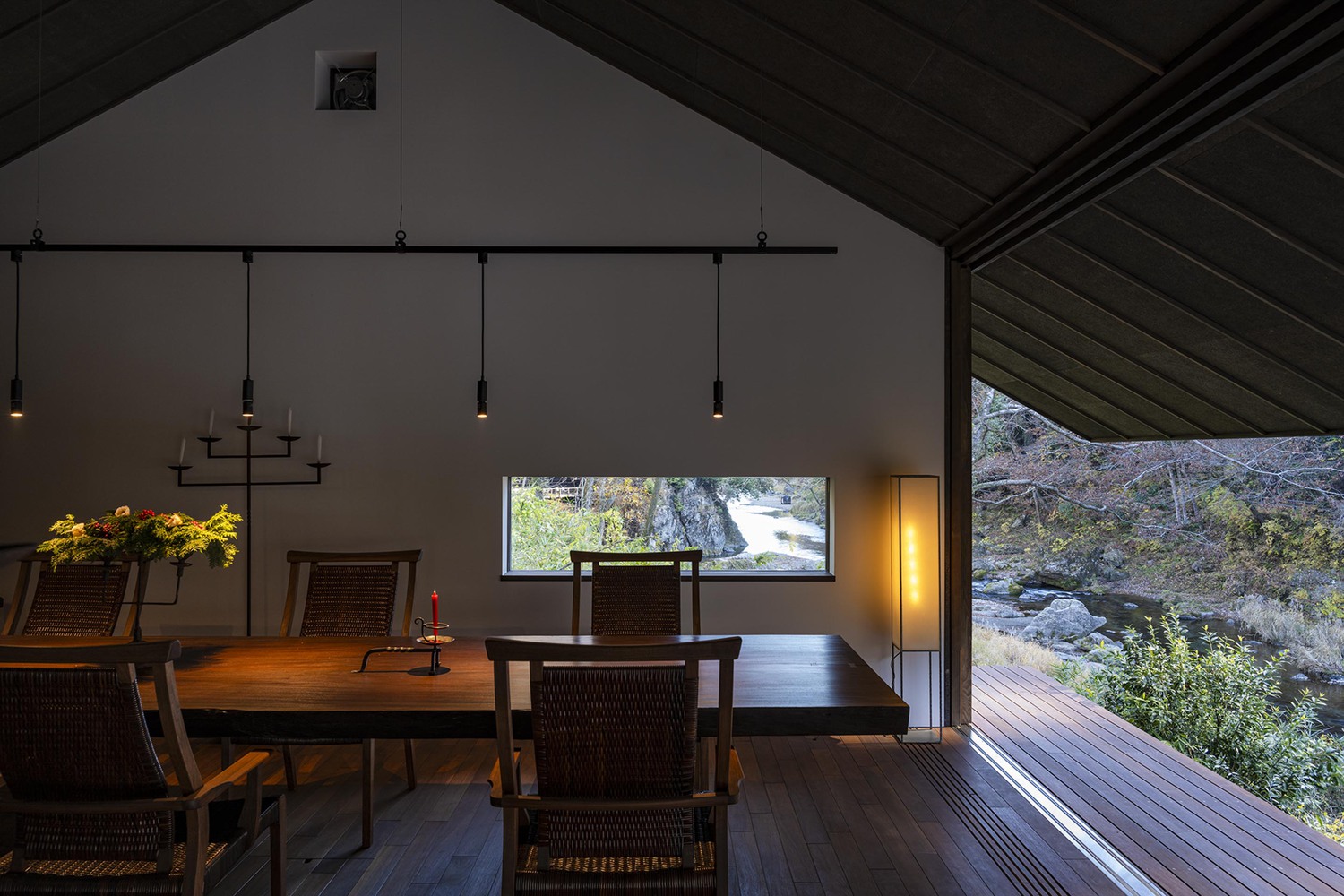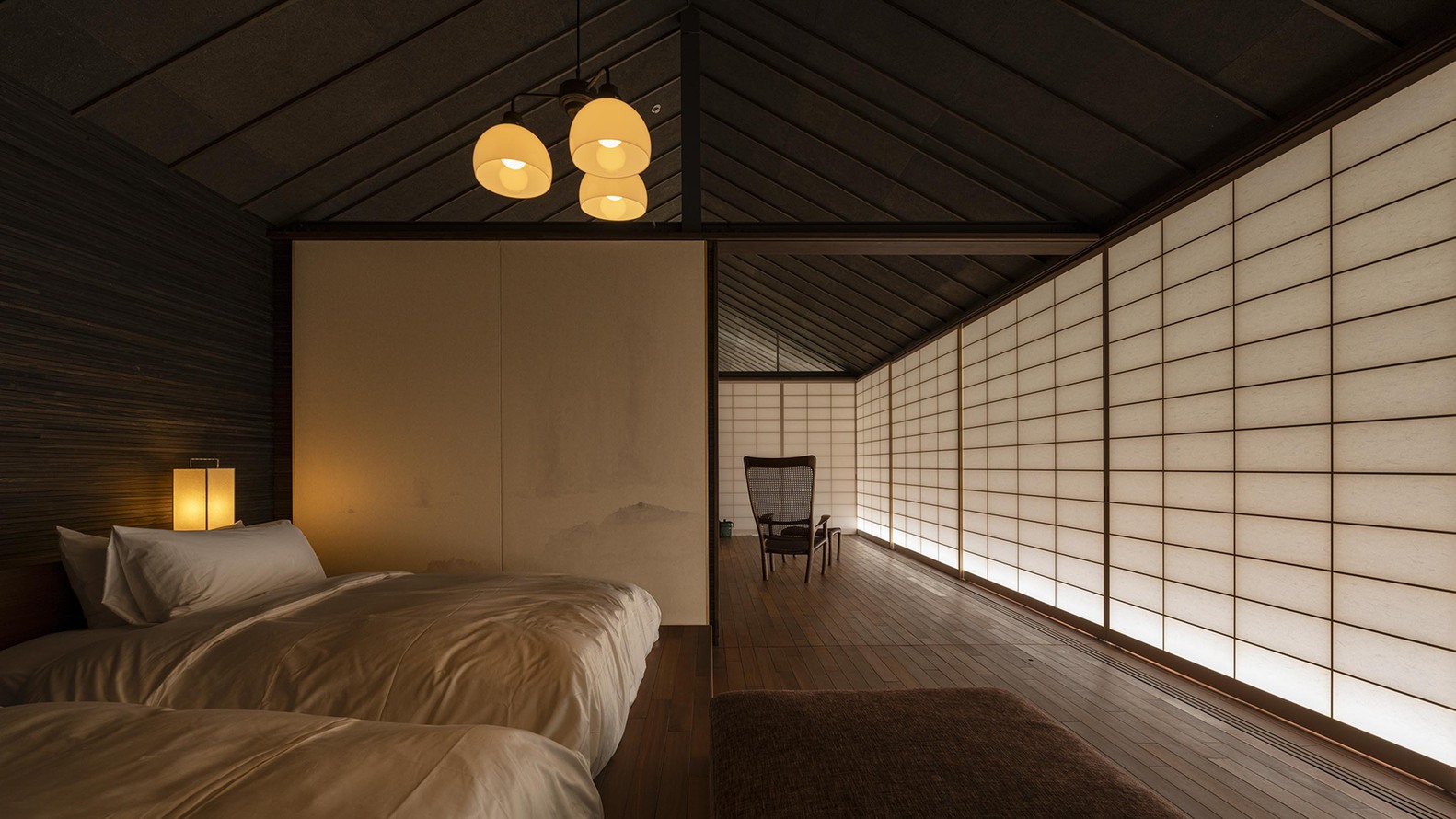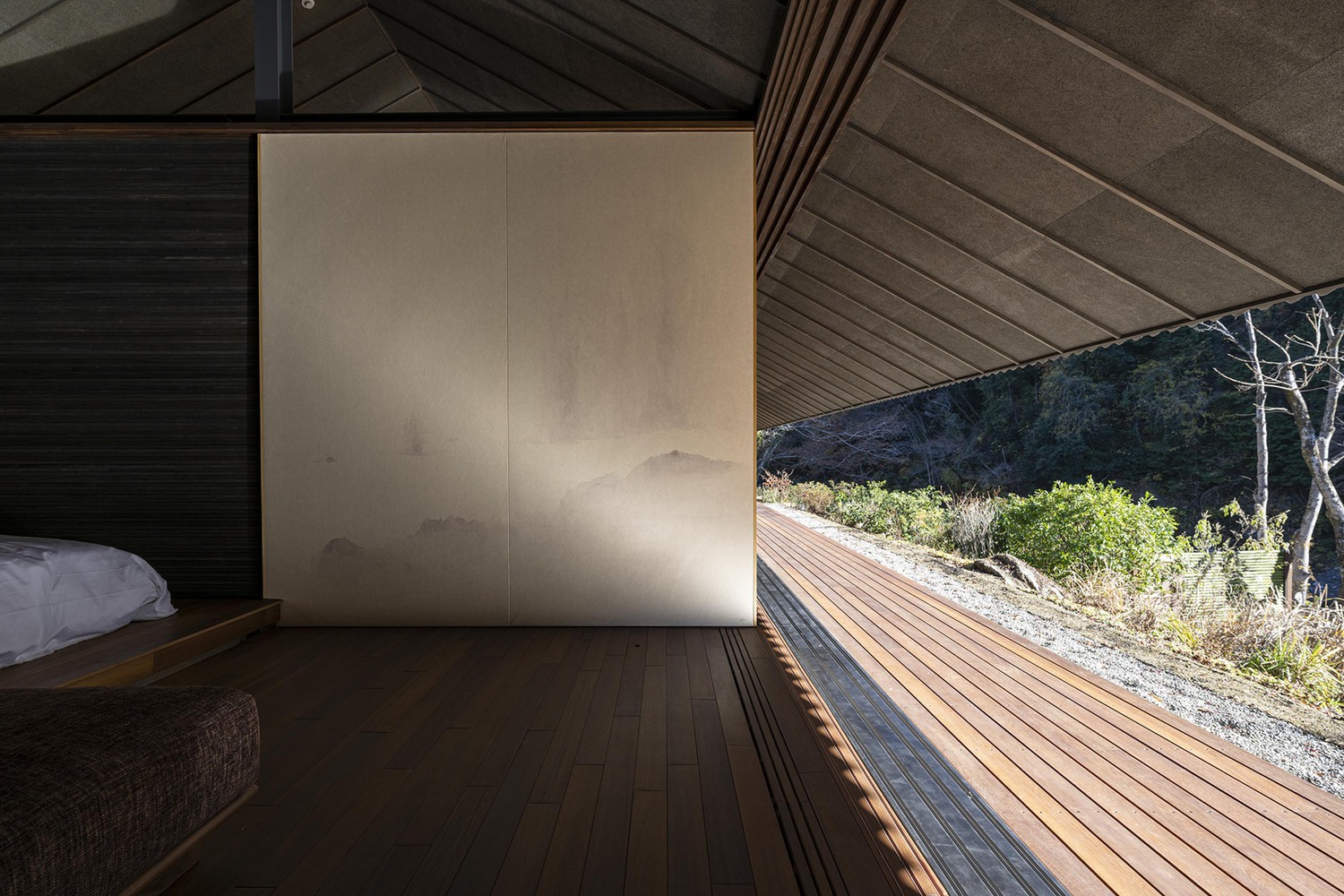"건축은 자연과 대화하는 예술이다. 우리는 땅이 들려주는 이야기에 귀 기울여야 한다." - 안도 다다오(Tadao Ando)

 |
 |
 |
바람이 머무는 집: 테즈카 아키텍츠의 후시 오베르주 Tezuka Architects-Fushi Auberge
계곡과의 만남: 도쿄 서부 아키가와의 숨은 보석
도쿄 서쪽 끝 아키가와 계곡 깊숙한 곳, 하루 한 팀만을 위한 특별한 오베르주 '후시(Fushi)'가 자리한다. 아키가와강과 본보리강이 만나는 합수 지점을 내려다보는 이 건물은, 서쪽으로 맑은 물줄기가 깎아낸 천연 요새 조야마산을 마주한다. 인간의 힘으로는 결코 만들어낼 수 없는 독특한 풍경이 펼쳐지는 이곳에, 반세기 넘게 가이세키 요리(일본 전통 코스 요리)를 이어온 가문이 새로운 건축적 실험을 선보였다.
33미터 무주공간의 기적: 현대 공학이 빚어낸 전통의 재해석
이 건물의 가장 놀라운 특징은 기본적으로 목구조 시스템을 취하면서도, 처마를 지탱하는 철골 프레임을 고도로 정교한 현대 공학 기술로 설계했다는 점이다. 아키가와 계곡의 기후와 문화 속에서 살아가는 지혜를 추구하는 자연스러운 형태로 구현되었다.
웅장한 지붕선이 대지와 감각적으로 통합되어 있다. 바닥에서 1.5미터 높이로 올라가 일반적인 일본인의 시선 높이에 맞춰 설계된 처마는, 33미터를 기둥 없이 수평으로 뻗어나간다. 이는 백만 년 강물의 침식이 만들어낸 독특한 석재 배열과 맑디맑은 물줄기를 방해받지 않고 바라볼 수 있도록 초대한다. 아키가와 계곡의 풍경이 두루마리 그림처럼 눈앞에 펼쳐진다.
바람이 머무는 집: '야외 거실'이라는 새로운 공간 개념
건물의 핵심에는 '야외 거실(Outdoor Living)'이 자리한다. 깊고 낮은 처마로 덮인 넓은 야외 데크는 앞으로 아키가와 계곡 풍경을 두루마리처럼 펼쳐 보이고, 뒤로는 대나무 숲 중정을, 그리고 건물 사이사이로 은은한 바람이 흘러들어 대지의 정수를 온전히 체현한다.
오베르주의 이름인 '후시(風姿)'는 노 마스터 제아미 모토키요의 텍스트 '風姿花傳(후시카덴)'에서 차용했다. 이곳은 경계를 정의하는 벽이나 기둥 없이도 노 무대가 될 수 있다. 계절에 따라 '무대 설정'을 바꾸며, 비와 눈조차 분위기의 일부가 된다.
2만 개 판재로 쌓은 정교함: 보이지 않는 디테일의 힘
벽체는 2만 개가 넘는 19mm 크기의 삼나무 판재를 1mm 간격으로 평행하게 배열하여 만들어졌다. 외부 벽은 빗물의 방향에 따라 수직으로, 내부 벽은 바람의 흐름 방향에 따라 수평으로 설치했다. 표면에서는 단 하나의 못도 보이지 않는다.
미닫이 스크린 양면에는 '새벽'과 '저녁'이라는 두 점의 오리지널 후스마 그림이 그려져 있다. 새벽은 해가 뜨기 직전 순간의 희미한 빛을, 저녁은 밤이 내리기 직전 순간의 예감에 찬 색조를 담았다.
경험으로서의 건축: 무형의 가치를 실현하는 공간
최근 건축 논의는 건축을 '오브제'가 아닌 '경험'으로 사고하는 방향으로 전환하고 있다. 하지만 인류 역사만큼이나 긴 건축의 역사를 경험과 이론만으로 설명하기는 불가능하다. 이 프로젝트는 건축의 무형적 요소들을 드러내며, 경험적 만족과 물리적 완성도 사이의 균형을 실현한다.
건축의 아름다움과 숭고함에 대한 경험이 요리, 도자기, 꽃꽂이, 노, 정원과 하나의 전체로서 스며든다. 후시 오베르주는 단순히 머무는 공간을 넘어, 일본 전통 문화의 정수를 현대적 공간 경험으로 재해석한 총체적 예술 작품이다.
Write by Claude & Jean Browwn

















"Fushi" is an auberge limited to one group per day, nestled deep in the Akigawa Valley on the western edge of Tokyo. The building overlooks the confluence of the Akigawa and Bonbori Rivers. To the west is Mount Joyama, a natural mountain fortress carved by clear streams. The site has a unique landscape that could not be achieved by human power. The auberge was founded by a family that has been running Kaiseki-Ryori (Traditional Multi course meals) restaurants for over half a century.
The building is basically made of timberworks, but the eave is held in place by a steel framed structure, carefully designed with highly skilled modern engineering. It is a natural form that seeks the wisdom of living in the climate and culture of the Akigawa Valley.
A heroic roof is sensibly integrated into the site. It rises 1.5 meters from the floor, designed to the eye level of the average Japanese. The eave spans 33 meters horizontally without pillars. It invites one to look toward the remarkably clear water stream with one-of-a kind stone arrangements that can only be achieved by a million years of river erosion. The scenery of the Akigawa Valley unfolded in front of one's eye like a scroll painting.
"Outdoor Living" is found at the heart of the building. It is an expansive outdoor deck covered with deep and low eaves, with a scroll of the Akigawa Valley landscape in front, the bamboo grove courtyard in the background, and a gentle breeze flowing through the building, fully embodying the essence of the site. Hence, the auberge is named "Fushi" (Figure of Wind), borrowed from Noh Master Zeami Motokiyo's text "Fushikaden" (The Transmission of the Flower of Acting Style). This place can also be a Noh stage, too, without a wall or pillar to define its boundaries. It changes its "setting" according to the seasons. Rain and snow also become part of the atmosphere.
The walls are made of over 20 thousand cedar wood strips, sized 19mm, aligned in parallel with a one millimeter gap between them. The exterior walls are made vertically in the direction of the rainfall; the interior walls are made horizontally in the direction of the breeze flow. Not a single nail is visible from the surface.
There are two original fusuma paintings on two sides of a sliding screen, Dawn and Evening. Dawn is the faint glow of the moment before the sun rises, while Evening is tinted with the foreboding hues of the moment before the night falls.
Recent discussions of architecture have shifted from thinking of architecture as an "object" to an "experience." However, the history of architecture is almost as long as the history of mankind, it is impossible to explain the qualities of architecture through experience and theory alone. This project reveals the intangible elements of architecture, realising the balance between experiential satisfaction and physical integrity. Experience of beauty and sublimity of architecture permeated the cuisines, ceramics, flowers, Noh, and gardens as a whole.
from archdaily